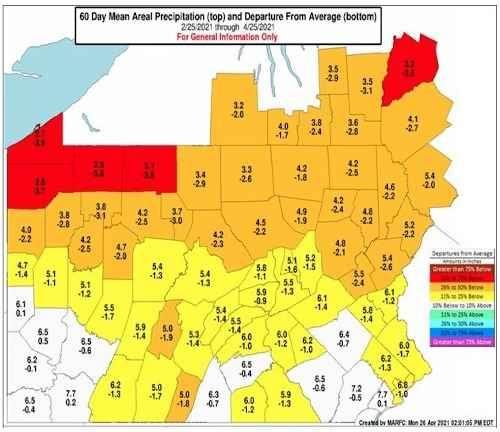By Heidi Reed and Sjoerd Willem Duiker
Dry soils and mixed predictions for expected rainfall could make planting green tricky.
This article is this week’s Agronomy Highlight, live on Fridays at 9:00 am. The Agronomy Highlight is an opportunity for readers to ask the author questions and hear updates from around Pennsylvania. Join the Agronomy highlight live on Facebook or zoom or join by calling +1 646 876 9923, and when prompted enter the webinar ID: 946 6516 7271.
Much of the state has received below average rainfall over the past 60 days (Figure 1). While above average rainfall is predicted for two weeks from now, below average rainfall is still expected for the coming week.

Figure 1: 60 day mean precipitation and departure from average 2/25/2021 through 4/25/2021. Mid-Atlantic River Forecast Center, Accessed 4/27/2021.
Planting green, or planting into a living cover crop, continues to grow in popularity for many reasons, including soil moisture management, soil conservation, and weed suppression, plus some reports of slug suppression. However, it is crucial to consider current soil moisture conditions and expected rainfall if you consider planting green.
Our research shows that planting green significantly dries the top three inches in the soil profile compared to planting into cover crops killed a week or more pre-plant. This is because the growing cover crop transpires and draws water out of the root zone. A drier seedbed can be a great benefit in a wet spring but can be detrimental for the main crop in a dry spring. On the other hand, the increased mulch cover after planting green conserves soil moisture in summer.
To terminate the cover crop now or wait and then plant green is a judgment call every farmer has to make themselves. As a guideline, if current soil moisture conditions are dry as seems to be the case in a fairly large portion of the state (Figure 1), and there is little rainfall in the forecast, it is wise to terminate the cover crop now and plant when the cover crop mulch is dry and crisp.
If, however, you do decide to plant green this year, know and understand these best management practices for the highest likelihood of success:
- Soybeans are more adaptable to planting green than corn; get comfortable with soybeans first.
- Equipment must be well maintained and calibrated
- Roll cover crops over 18 inches tall
- -- Use aggressive row cleaners to help warm soil in the furrow
- Planters work better for soybean establishment through thick cover than drills, due to better seed placement
- Check if you are planting deep enough; you must account for the residue thickness
- Put an extra 50 pounds per acre of N at corn planting to compensate for N-tie up by a cereal cover crop with the remainder of N needs applied at side-dress based on yield goals. PSNT and tissue sampling can help dial in N needs.
- Scout for early season pests and use IPM to manage pests.
- Minimize neonicotinoid seed treatments and pre-emptive insecticide sprays that can kill predators of insect and slug pests, which are allies in pest control
- Consult with farmers in your area who have planted green successfully
Source : psu.edu